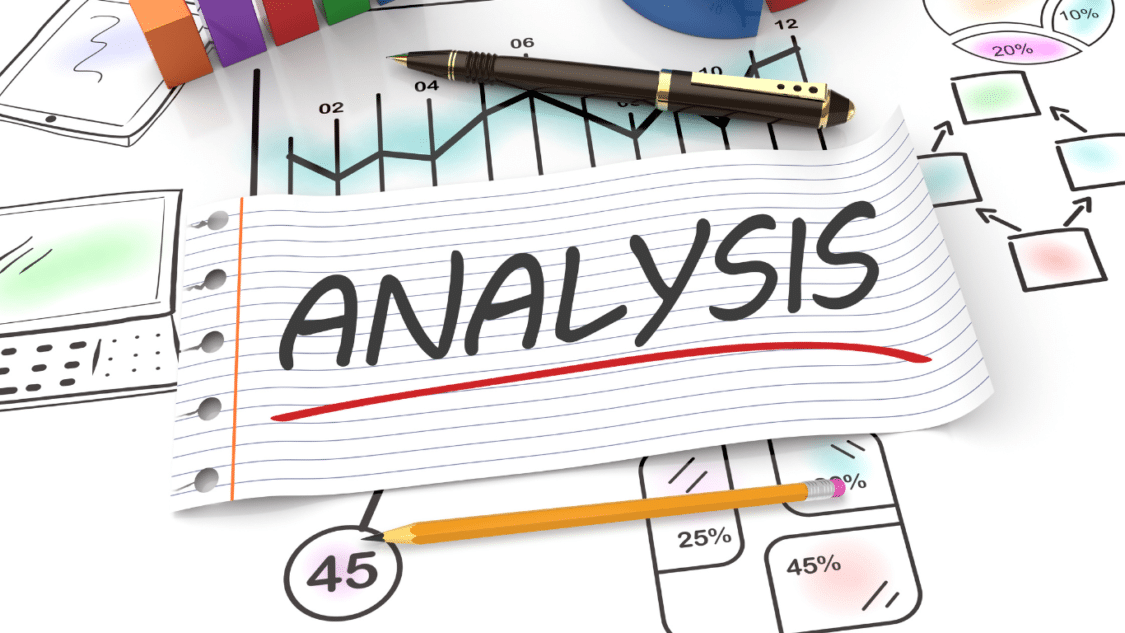An essential step in trading efficiently in the crypto market is being familiar with the common types of cryptocurrency analysis. The CEO of a large crypto hedge fund, Su Zhu, believes, “If you don’t understand crypto and refuse to learn, it’s gonna be a tough century for you.”

Investing in cryptocurrency is risky and volatile, and while there is the risk of losing, many believe that crypto is the way to the future. Therefore, as you analyze any crypto asset, think of the market as a stock exchange and apply any methods of crypto analysis that will provide you with the proper understanding of future trends and activities.
Let’s discuss the common types of cryptocurrency analysis. Fundamental, technical, on-chain analysis, and sentimental analysis.
Fundamental Analysis
As the most common crypto analysis option, fundamental analysis focuses on all the information available on cryptocurrency. Using quantitative financial metrics and qualitative measures, it strives to conclude with an intrinsic price of the cryptocurrency. Once the fundamental value is determined, you can compare it to the current market price and determine whether the crypto asset is undervalued or overvalued.
Fundamental analysis is a comprehensive and strategic approach used to evaluate the intrinsic value of a financial asset, such as stocks, bonds, or cryptocurrencies. It involves analyzing various fundamental factors, including financial statements, economic indicators, management performance, industry trends, and competitive positioning, to assess the investment potential of an asset.
Wanna buy crypto ?Click here and claim your free bonus
The fundamental analysis enables investors to gain a deep understanding of the underlying fundamentals of an asset, helping them make informed investment decisions. Investors can evaluate a company’s financial health, profitability, and growth prospects by examining financial reports, such as balance sheets, income announcements, and cash flow statements.
Economic indicators, like GDP growth, inflation, and interest rates, provide insights into the macroeconomic environment and its impact on investments. Analysis of management performance, including leadership quality, corporate governance, and strategic initiatives, helps assess the competence and vision of the company’s management team. Industry trends and competitive positioning analysis shed light on the market dynamics, competitive landscape, and potential risks and opportunities.
With a thorough understanding of fundamental factors, investors can identify undervalued or overvalued assets, assess the risks and rewards of an investment, and make informed decisions based on a long-term investment horizon. The fundamental analysis serves as a critical tool for investors to assess the intrinsic value of an asset, understand its growth potential, and determine its suitability in their investment portfolio.
Wanna buy crypto ?Click here and claim your free bonus
Nevertheless, it’s important to note that fundamental analysis has its limitations, including the availability and accuracy of data, subjective interpretations, and the unpredictable nature of markets. Complementing the fundamental analysis with other forms of research, such as technical analysis and risk management strategies, is crucial to make well-rounded investment decisions.
An undervalued asset represents the trader with a buying opportunity, whereas an overvalued asset can mean its time to take profits.

Technical Analysis
Technical Analysis is the following well-known option for cryptocurrency analysis. This form of crypto analysis looks at previous price movements in the crypto market. It concludes with results on which direction the market is going next.
Each event’s likelihood is calculated using various statistical indicators and trends. Even though they utilize statistical measurements, traders primarily rely on visual charts to help them recognize necessary signals like support and resistance. Technical analysis is ultimately used to identify buy and sell signals.
Of course, no form of analysis is 100% full proof. Therefore, even if a trader is correct 55% of the time, that is already a success. Traders often use risk management practices to prevent losses and manage risks when these forms of analysis contradict their predictions. Such as the option of setting auto sales as well as choosing to portion off their assets on a trade.

On Chain Analysis
On-chain analysis refers to the meticulous examination of blockchain data to gain insights into the flow of digital assets, transaction patterns, and address activity. It is a critical tool for investors and businesses to make informed decisions and manage risks in the ever-evolving cryptocurrency market.
Through on-chain analysis, financial advisors and investors can assess the health of a blockchain network by examining key metrics such as transaction volumes, transaction fees, and transaction times. These insights can provide valuable information about the adoption and usage of a cryptocurrency, which can help evaluate its potential for growth and investment opportunities.
Furthermore, on-chain analysis can also provide insights into the behavior of market participants. Financial advisors can identify trends and patterns that may indicate market sentiment, investor activity, and potential market manipulation by analyzing address activity and transaction patterns. This information can be crucial in devising investment strategies and managing risks in a highly volatile market.
However, it’s important to note that on-chain analysis has its limitations. Blockchain networks often prioritize privacy and security, making it challenging to trace the identity of users involved in transactions. Additionally, the on-chain analysis may provide a partial picture of market dynamics and require additional tools and techniques for a comprehensive analysis.
This analysis differs from the previous two because it looks at public data in the blockchain network. The most common use for on-chain analysis is identifying the reason behind market participants and why they are buying or selling. When using this analysis, traders examine the differences between market users and their behavior. Whether institutional investors, miners, or retail traders, some of the standard signals they use to identify this are wallet balances, coin dormancy, or transaction volume.
In conclusion, on-chain analysis is a powerful tool for financial advisors and investors to gain insights into the cryptocurrency market and manage risks effectively. It provides valuable information about blockchain data and transaction patterns, which can aid in making informed investment decisions. However, it’s crucial to recognize the limitations of the on-chain analysis and use it with other analytical tools for a comprehensive understanding of the cryptocurrency market.
Sentimental Analysis
Understanding Sentiment Analysis: Sentiment analysis(opinion mining) is a process that involves extracting emotions, attitudes, and opinions from text data. This can include social media posts, news articles, forum discussions, and more. Sentiment analysis uses NLP algorithms and machine learning techniques to analyze the tone and sentiment of the text, classifying it as positive, negative, or neutral. The goal is to understand the overall sentiment conveyed in the text and gain insights into how people feel about a particular topic or subject.
An additional approach is known as Sentimental Analysis which pertains to stock investing. This method requires a lot of caution and pertains to crypto exchanges. Sentimental analysis requires you to look past the numbers to see what certain market players think and feel. These players can be journalists, investors, influencers, economists, or hedge fund managers.
Sentiment Analysis in the Cryptocurrency World: The cryptocurrency market is highly influenced by public sentiment, as market participants’ emotions and perceptions drive it. Sentiment analysis is being utilized in the cryptocurrency world to understand the feeling of the community, track market trends, and make informed investment decisions. Here are some key areas where sentiment analysis is being applied in the cryptocurrency world:
- Market Sentiment Analysis: Sentiment analysis tracks and analyzes the sentiment of the overall cryptocurrency market. By monitoring social media posts, news articles, and other relevant data, sentiment analysis can provide insights into whether the sentiment is bullish, bearish, or neutral. This information can help traders and investors gauge market sentiment, identify potential trends, and make informed trading decisions.
- Coin-specific Sentiment Analysis: Sentiment analysis is also used to analyze the sentiment of specific cryptocurrencies. By monitoring social media mentions, news articles, and other online discussions, sentiment analysis can provide insights into how people perceive a particular cryptocurrency. Positive sentiment may indicate growing interest and potential for price appreciation, while negative sentiment may suggest concerns or potential risks.
- ICO Sentiment Analysis: Sentiment analysis is utilized in the Initial Coin Offering (ICO) space to assess the sentiment toward new cryptocurrency projects. By analyzing social media posts, news articles, and other relevant data, sentiment analysis can provide insights into how the community perceives an ICO project. Positive sentiment may indicate a higher likelihood of a successful ICO, while negative sentiment may suggest potential risks or lack of interest.
- Sentiment-based Trading Strategies: Sentiment analysis is also used to develop sentiment-based trading strategies in the cryptocurrency market. By using sentiment analysis as a tool for decision-making, traders can incorporate sentiment signals into their trading strategies. For example, if sentiment analysis indicates positive sentiment towards a particular cryptocurrency, a trader may consider taking a long position, while negative sentiment may prompt a short position.
The caution with this analysis is that the data doesn’t always indicate what’s going on in the market.
Benefits and Limitations of Sentiment Analysis in the Cryptocurrency World:
Sentiment analysis offers several advantages in the cryptocurrency world. It provides valuable insights into market sentiment, helps track market trends, and guides investment decisions. By understanding public sentiment, traders and investors can make informed decisions and potentially gain an edge in the volatile cryptocurrency market.
If you notice a significant increase in trust (or a decrease), it may indicate that rapid growth or drop is imminent and that the market hasn’t yet reacted.

A Combination
While each method of is to be used alone, combining them makes for a powerful crypto analysis. A single metric by itself might not be helpful. But by combining all of your analysis techniques, you can create a captivating market image.
Of course, not all three must align for your trade to go through. You can enter and exit positions as the market shifts by maintaining your risk management procedures and making the proper allocations.
As often thought, a cryptocurrency exchange is not the same as a stock market exchange. Although there is undoubtedly more upside, there is also a severe downside due to the increased volatility. You can improve your chances of success by using technical, fundamental, sentimental, and on-chain analysis when trading.
Wanna buy crypto ?Click here and claim your free bonus
Want to Know More About Ethereum Gas Fees?
